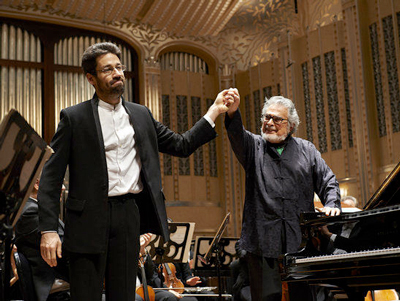by Daniel Hathaway

Beethoven would undoubtedly have been proud of the unbroken tradition passed down through his student Carl Czerny to Theodor Leschetizky to Artur Schnabel to Leon Fleisher and finally to Fleisher’s student Jonathan Biss. George Szell (who probably hovers not too far away) would have beamed avuncularly to see Fleisher, his first invited Cleveland Orchestra soloist, taking a turn on the podium. And Mendelssohn (certainly a regular at the heavenly party) would have been delighted to hear his Hebrides Overture elevated from picture postcard status to an evocative tone poem. It was a great evening both for participants and onlookers — whether ensconced in plush seats on Euclid Avenue or floating among the clouds.
Only five years separates Beethoven’s second and third concertos (completed in 1795 and 1800), but the two works come from different worlds. The B-flat concerto, even with its distinctive Beethovinian touches, behaves more like a classical period work by Haydn or Mozart. The C minor concerto is grander, more symphonic, and suffused with the drama Beethoven always associates with that key (think the fifth symphony or the “Pathétique” Sonata).
On Thursday evening, that five-year gap was simulated by an intermission, which either gave performers and listeners an opportunity to reset their ears or deprived them of the opportunity to make a direct comparison between the concertos. In both works, Fleisher set up rich, colorful introductions for the solo piano and from that point, Biss took them over and possessed each of them in a singular way.
He played the B-flat concerto with elegant brilliance, pointing up the playfulness and beguilingly ambiguous rhythmic structure of its Rondo theme (are those upbeats in the theme or do they land on the beat? What about later in the movement?) In the c-minor concerto, Biss gave more weight and import to his tone though not skimping on brilliance. That’s partly because Beethoven gave fuller textures to the solo part in the third concerto, but Biss’s command of touch and style was stunning in both works. Both slow movements were unhurried and lustrous.
Conducting from a stool, Fleisher guided the concertos with a sure hand but gave Biss room to shape his own concept of the works. The Cleveland Orchestra sounded predictably wonderful. An occasional moment of ensemble imprecision might have raised eyebrows in Szell’s heavenly chambers, but mattered little in the thrill of Thursday’s performances, which roused the audience to enthusiastic ovations and won Biss multiple callbacks.
Fleisher had sole and complete control over the Mendelssohn overture that began the evening. Most often, the piece surges gently and uneventfully along like the waves gushing in and out of Fingal’s Cave, but like a curious tourist with time on his hands, Fleisher found lots of details he wanted to take a closer look at, clearly demarcating sections and playing with tempos and pacing. Unusual but fascinating!
Photo by Roger Mastroianni.
Published on ClevelandClassical.com December 12, 2013
Click here for a printable version of this article.



